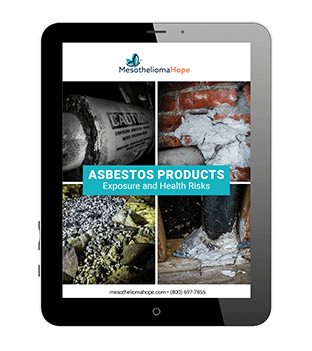Mesothelioma terminology can be complex and difficult to understand. This can make it harder for mesothelioma patients and their loved ones to get the most out of their care. A mesothelioma medical terminology breakdown can help patients understand this disease and its treatment options.
Breaking Down Mesothelioma Medical Terminology
Those who are newly diagnosed with mesothelioma may be overwhelmed with all the complex medical terms. Our mesothelioma medical terminology breakdown provides patients and their families with concise and easy-to-understand definitions for medical terms related to this cancer.
Mesothelioma: Causes and Types
- Mesothelioma: Mesothelioma is cancer that affects the lining of the lungs, abdomen, heart, or testicles. Individuals develop mesothelioma from inhaling or swallowing asbestos fibers decades earlier. There is no cure for mesothelioma, but different treatments may help improve a patient’s life span.
- Asbestos: Asbestos is the only known cause of mesothelioma. Between the 1930s and 1980s, this fiber-like mineral was used in industrial materials and fabrics since it was durable and heat resistant. Manufacturers knew asbestos could cause deadly diseases but hid the facts. As a result, firefighters, construction workers, and others who worked around asbestos are at a high risk of mesothelioma today.
- Types of mesothelioma: Someone may develop one of four different types of mesothelioma, depending on where asbestos fibers get lodged in their body.
- Pleural: Pleural mesothelioma first develops in the pleura (the lining of the lungs). It is considered the most common form of mesothelioma.
- Peritoneal: Peritoneal mesothelioma affects the peritoneum (abdomen lining). It is the second-most common form of mesothelioma.
- Pericardial: Pericardial mesothelioma affects the pericardium (heart lining). This is a rare form of mesothelioma.
- Testicular: Testicular mesothelioma develops in the tunica vaginalis (testicle lining). It is the rarest mesothelioma type.
Stages of Mesothelioma and Different Cell Types
- Stages of mesothelioma: There are four stages of mesothelioma. Stage 1 is the least advanced and has the most treatment options available. Stage 4 is the most advanced and treatment is mainly focused on keeping the patient comfortable.
- Only pleural mesothelioma is broken up into stages. All other types of mesothelioma do not have stages but are instead classified as local or advanced.
- Early warning signs of mesothelioma (persistent cough, shortness of breath, fluid buildup) are key to diagnosing the cancer in its earlier stages.
- Sadly, most people are not diagnosed until the cancer has reached its advanced stages as the symptoms are relatively mild at first and often go undetected.
- Mesothelioma cell types: Mesothelioma tumors are made up of different types of cells. Which mesothelioma cell type is present determines how fast the cancer spreads and can affect a patients’ life expectancy.
- Epithelioid: Epithelioid mesothelioma is the most common cell type. It tends to be the easiest to treat.
- Sarcomatoid: Sarcomatoid mesothelioma is the rarest of all mesothelioma cell types. It is difficult to treat, and is more likely to spread throughout the body to other organs.
- Biphasic: Biphasic tumors contain both epithelioid and sarcomatoid cells. How they respond to treatment depends on which cell type is more dominant. If more sarcomatoid cells are present, the cancer may spread faster and not respond as well to treatments.
Mesothelioma Prognosis and Treatments
- Prognosis: The prognosis for a medical condition is the long-term outlook for a patient. The prognosis is sometimes conflated with life expectancy. Generally, the prognosis for mesothelioma is poor, as it is considered a terminal illness and there is no cure.
- Life expectancy: Life expectancy is how long patients are expected to live after developing mesothelioma. Currently, most mesothelioma patients have a life expectancy of up to 22 months. However, since most cases are diagnosed in their later stages, most patients live about one year after diagnosis.
- Survival rate: Survival rates measure the percentage of patients who survive after a set period of time, such as one year or five years. The American Cancer Society found that the over five-year survival rate for pleural mesothelioma was 10%.
- Treatments: There are several different treatments for mesothelioma Doctors determine which treatments should be used on patients based on overall health, age of diagnosis, stage at diagnosis, and other factors.
- Extrapleural pneumonectomy (EPP): An EPP is used to treat pleural mesothelioma patients and involves the surgical removal of a lung, as well as a portion of the diaphragm and the linings of both the heart and lungs.
- Pleurectomy with decortication (P/D): Also used to treat pleural mesothelioma, a P/D involves opening the chest cavity and then surgically removing the pleura (lining of the lungs) and any other visible tumors. This treatment is different from an EPP because it does not involve the removal of the lung.
- Cytoreduction with HIPEC: This treatment is used on peritoneal mesothelioma patients. It involves the surgical removal of tumors in conjunction with hyperthermic intraperitoneal chemotherapy (HIPEC), which can significantly increase life expectancy.
- Chemotherapy: Chemotherapy is a treatment that uses anti-cancer drugs to fight mesothelioma and other forms of cancer. Common chemotherapy drugs used for mesothelioma include pemetrexed, cisplatin, carboplatin, and vinorelbine.
- Radiation therapy: Radiation therapy treats mesothelioma by using high-energy X-rays in order to kill cancer cells. Radiation therapy can cause side effects such as fatigue and hair loss.
- Immunotherapy: Immunotherapy is the newest mesothelioma treatment as of 2021. It was approved by the Food and Drug Administration (FDA) for use on mesothelioma patients after years of research in October 2020. Immunotherapies train the immune system to identify and attack cancer cells.
- Clinical trials: Clinical trials are experimental treatments that are not yet available to the general public. Clinical trials offer access to new treatments, but there is no guarantee of their effectiveness. Mesothelioma patients can access these trials by contacting their local health care providers or hospitals.
- Palliative treatments: Palliative treatments focus on keeping the patient comfortable rather than helping them live longer, and are often offered when the mesothelioma can no longer be treated medically.
Learn More About Mesothelioma Medical Terminology
If you need a more in-depth mesothelioma medical terminology breakdown, contact our team. We have knowledgeable Patient Advocates and nurses standing by to answer any and all patient questions.
Our team can also help patients understand their financial options after a mesothelioma diagnosis. Patients may qualify for financial aid from a variety of sources, including legal action, trust funds, and the U.S. Department of Veterans Affairs (VA). Don’t wait: our team can help you right now.










